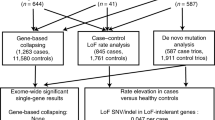Abstract
OCD is characterised by recurrent obsessions and compulsions that result in severe distress and increased risk for comorbidity. Recently published findings have indicated that the neuronal cadherin gene (CDH2) plays a role in the development of canine OCD, and led us to investigate the human ortholog, CDH2, in a human OCD cohort. Seven CDH2 polymorphisms were selected and genotyped in a South African Caucasian cohort of 234 OCD patients and 180 healthy controls using TaqMan assays. Polymorphisms were analysed in a single-locus and haplotypic context. Of the seven polymorphisms, two reached statistical significance for OCD under additive and codominant models of inheritance (rs1120154 and rs12605662). CDH2 SNP, rs1120154, C-allele carriers were found to be significantly associated with lower risk to develop OCD compared to TT-homozygotes (OR = 0.49; 95 % CI: 0.32–0.75; p < 0.001), and rs12605662 G-allele carriers were significantly associated with reduced risk OCD compared to TT-homozygotes (OR = 0.46; 95 % CI: 0.30–0.71; p < 0.001), Furthermore, a single haplotype was found to infer an increased risk for OCD diagnosis (*rs8087457-rs1148374: A-T). Polymorphisms within the CDH2 gene are associated with susceptibility to OCD in a South African cohort.

Similar content being viewed by others
References
Arnold PD, Rosenberg DR, Mundo E et al (2004) Association of a glutamate (NMDA) subunit receptor gene (GRIN2B) with obsessive-compulsive disorder: a preliminary study. Psychopharmacology 174:530–538
American Psychiatric Association (APA) (2000) Diagnostic and statistical manual of mental disorders, fourth edition: DSM-IVTR®. American Psychiatric Pub, Washington DC
Chakrabarty K, Bhattacharyya S, Christopher R, Khanna S (2005) Glutamatergic dysfunction in OCD. Neuropsychopharmacology 30:1735–1740
Dodman NH, Karlsson EK, Moon-Fanelli A et al (2010) A canine chromosome 7 locus confers compulsive disorder susceptibility. Mol Psychiatry 15:8–10. doi:10.1038/mp.2009.111
First M, Spitzer R, Gobbon M, Williams JB (1998) Structured clinical interview for DMS-IV Axis I disorders-patient edition (SCID-I/P, Version 2.8, 8/98 revision). New York State Psychiatric Institute, New York
Fontenelle LF, Hasler G (2008) The analytical epidemiology of obsessive–compulsive disorder: risk factors and correlates. Prog Neuro-Psychopharmacol Biol Psychiatry 32:1–15
Gabriel SB, Schaffner SF, Nguyen H et al (2002) The structure of haplotype blocks in the human genome. Science 296:2225–2229
González JR, Armengol L, Guinó E et al (2013) Package “SNPassoc”
Goodman WK, Price LH, Rasmussen SA et al (1989) The Yale-Brown obsessive compulsive scale. II. Validity. Arch Gen Psychiatry 46:1012–1016
Goodwin M, Yap AS (2004) Classical cadherin adhesion molecules: coordinating cell adhesion, signaling and the cytoskeleton. J Mol Histol 35:839–844. doi:10.1007/s10735-004-1833-2
Grant P, Lougee L, Hirschtritt M, Swedo SE (2007) An open-label trial of riluzole, a glutamate antagonist, in children with treatment-resistant obsessive-compulsive disorder. J Child Adolesc Psychopharmacol 17:761–767
Hemmings SM, Kinnear CJ, Lochner C et al (2004) Early-versus late-onset obsessive–compulsive disorder: investigating genetic and clinical correlates. Psychiatry Res 128:175–182
Hettema JM, Neale MC, Kendler KS (2001) A review and meta-analysis of the genetic epidemiology of anxiety disorders. Am J Psychiatry 158:1568–1578
Kariuki-Nyuthe C, Gomez-Mancilla B, Stein DJ (2014) Obsessive compulsive disorder and the glutamatergic system. Curr Opin Psychiatry 27:32–37. doi:10.1097/YCO.0000000000000017
Kessler RC, Angermeyer M, Anthony JC et al (2007) Lifetime prevalence and age-of-onset distributions of mental disorders in the World Health Organization’s World Mental Health Survey Initiative. World Psychiatry 6:168–176
Kroisel PM, Windpassinger C, Wagner K et al (2004) De novo translocation t(5;18)(q33.1;q12.1) associated with autistic disorder. Am J Med Genet A 129A:98–100. doi:10.1002/ajmg.a.30150
Lochner C, Hemmings SM, Kinnear CJ et al (2005) Cluster analysis of obsessive-compulsive spectrum disorders in patients with obsessive-compulsive disorder: clinical and genetic correlates. Compr Psychiatry 46:14–19
Moon-Fanelli AA, Dodman NH, Famula TR, Cottam N (2011) Characteristics of compulsive tail chasing and associated risk factors in bull terriers. J Am Vet Med Assoc 238:883–889. doi:10.2460/javma.238.7.883
Moya PR, Dodman NH, Timpano KR et al (2013) Rare missense neuronal cadherin gene (CDH2) variants in specific obsessive-compulsive disorder and Tourette disorder phenotypes. Eur J Hum Genet 21:850–854. doi:10.1038/ejhg.2012.245
Overall KL, Dunham AE (2002) Clinical features and outcome in dogs and cats with obsessive-compulsive disorder: 126 cases (1989–2000). J Am Vet Med Assoc 221:1445–1452
Pagnamenta AT, Khan H, Walker S et al (2011) Rare familial 16q21 microdeletions under a linkage peak implicate cadherin 8 (CDH8) in susceptibility to autism and learning disability. J Med Genet 48:48–54. doi: 10.1136/jmg.2010.079426
Schaid DJ, Sinnwell JP, Thibodeau SN (2005) Robust multipoint identical-by-descent mapping for affected relative pairs. Am J Hum Genet 76:128–138
Shapiro L, Love J, Colman DR (2007) Adhesion molecules in the nervous system: structural insights into function and diversity. Annu Rev Neurosci 30:451–474. doi:10.1146/annurev.neuro.29.051605.113034
Tang R, Noh HJ, Wang D et al (2014) Candidate genes and functional noncoding variants identified in a canine model of obsessive-compulsive disorder. Genome Biol 15:R25. doi:10.1186/gb-2014-15-3-r25
Tomaselli KJ, Neugebauer KM, Bixby JL et al (2008) N-cadherin and integrins: two receptor systems that mediate neuronal process outgrowth on astrocyte surfaces. Neuron 60:398–399. doi:10.1016/j.neuron.2008.10.030
Van Grootheest DS, Cath DC, Beekman AT, Boomsma DI (2005) Twin studies on obsessive–compulsive disorder: a review. Twin Res Hum Genet 8:450–458. doi:10.1375/twin.8.5.450
Wang K, Zhang H, Ma D et al (2009) Common genetic variants on 5p14.1 associate with autism spectrum disorders. Nature 459:528–533. doi:10.1038/nature07999
Acknowledgments
We would like to acknowledge the National Research Foundation (NRF) for funding.
Conflict of interest
The authors declare no conflict of interest.
Author information
Authors and Affiliations
Corresponding author
Rights and permissions
About this article
Cite this article
McGregor, N.W., Lochner, C., Stein, D.J. et al. Polymorphisms within the neuronal cadherin (CDH2) gene are associated with obsessive-compulsive disorder (OCD) in a South African cohort. Metab Brain Dis 31, 191–196 (2016). https://doi.org/10.1007/s11011-015-9693-x
Received:
Accepted:
Published:
Issue Date:
DOI: https://doi.org/10.1007/s11011-015-9693-x




